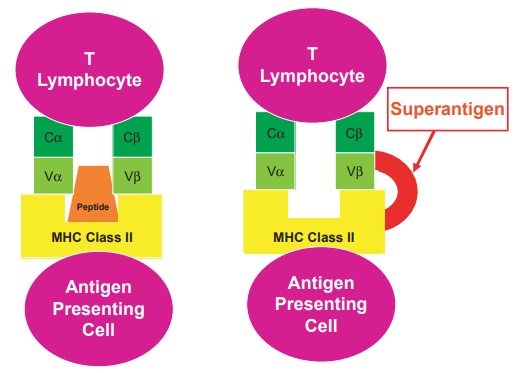Chapter: Essential Clinical Immunology: Immunological Aspects of Infection
Bacterial Superantigens

BACTERIAL SUPERANTIGENS
Among the toxins secreted by bacteria is a special
group from the streptococcal and staphylococcal family of
toxins called superantigens (SAg).
Instead of binding to the specific
antigen receptor known for most antigens, these toxins bind to the lateral
surface of both the T-cell receptor and the MHC (see Figure 4.3). Thus, in
contrast to a conventional peptide anti-gen, which stimulates only one in 104
to 108 T cells, the superantigen may bind up to approximately 1:50 T
cells. The result is a veritable explosion of cytokines result-ing in high
fever, hypotension, and mul-tiorgan shock. Death often occurs within 24 hours
of the release of these toxins. The most widely studied superantigens are
produced by Staphylococcus aureus and
group A streptococcus. These supe-rantigens bind the T-cell receptor at its β region, and that exact Vβ region is dif-ferent for each
superantigen. Table 4.2 lists the known superantigens and their Vβ specificities.
The role of SAg has also been explored in a number
of disease states, including atopic dermatitis, psoriasis, Kawasaki disease,
rheumatic fever, and tuberculosis.

Figure 4.3 Binding
of conventional (left) and superantigen (right) antigens to the T-cell
receptor and antigen-presenting cell. Note that the conventional antigen
binding is associated with the T-cell receptor and the major histocompatibility
complex (MHC) directly and only a small proportion of T cells are activated. In
contrast, the superantigen binds to the lateral sides of the T-cell receptor
and MHC molecule, thereby triggering a much larger group of activated T cells
(up to 25 percent of the cells).
Related Topics